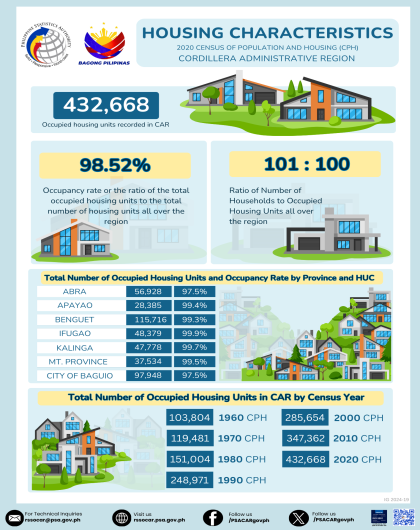| Census Year | Census Reference Date | Population |
|---|---|---|
| 2010 | May 1, 2010 | 12,082 |
| 2015 | August 1, 2015 | 12,195 |
| 2020 | May 1, 2020 | 12,914 |
From 2015 to 2020, the annual population growth rate of Balbalan is 1.21 percent, lower by 1.03 percent as compared from 2010 to 2015 with 0.18 annual population growth rate. (Table 2)
Table 2. Annual Population Growth Rate: Balbalan, Kalinga
| Reference Period | Annual Population Growth Rate (in percent) |
|---|---|
| 2010-2015 | 0.18 |
| 2015-2020 | 1.21 |
The municipality of Balbalan is composed of 14 barangays. Among the 14 barangays, 10 barangays or 71.43 percent increased in population as compared to 2015 population and 4 barangays decreased. These were barangays Balbalasang, Dao-angan, Poswoy and Talalang. There were seven (7) barangays that have more than 1000 population in 2020 and there were two (2) barangays that have less than 500 population. These were barangays Ababa-an with 445 persons and Maling (Kabugao) with 465 persons. (Table 3)
Table 3. Population by Barangay: Balbalan, Kalinga
| Barangay | Population | ||
|---|---|---|---|
| 2010 | 2015 | 2020 | |
| Ababa-an | 391 | 444 | 445 |
| Balantoy | 1,455 | 1,508 | 1,655 |
| Balbalan Proper | 1,016 | 974 | 1,103 |
| Balbalasang | 923 | 997 | 819 |
| Buaya | 779 | 816 | 1,040 |
| Dao-angan | 635 | 616 | 603 |
| Gawa-an | 1,006 | 997 | 1,067 |
| Mabaca | 697 | 611 | 616 |
| Maling (Kabugao) | 434 | 402 | 465 |
| Pantikian | 1,064 | 1,109 | 1,179 |
| Poswoy | 968 | 1,073 | 1.036 |
| Poblacion ( Salegseg) | 1,195 | 1,296 | 1,397 |
| Talalang | 628 | 495 | 603 |
| Tawang | 891 | 857 | 886 |
Among the 14 barangays in the municipality of Balbalan, the largest in terms of population size is Balantoy with 1,655 persons. It was followed by Poblacion (Salegseg) with 1,397 persons, Pantikian ranked 3rd with 1,197 persons, Balbalan Proper with 1,103 and Gawa-an with 1,067. The combined population of these five barangays accounted for about 49.57 percent of the total population of Balbalan in 2020. (Table 4)
Table 4. Top Five Most Populous Barangays: Balbalan,, Kalinga
| Barangay | 2020 Population |
| Balantoy | 1,655 |
| Poblacion (Salegseg) | 1,397 |
| Pantikian | 1,197 |
| Balbalan Proper | 1,103 |
| Gawa-an | 1,067 |
Barangay Ababa-an was the least populous barangay in the municipality of Balbalan with 445 persons. It was followed by Maling (Kabugao) with 465 persons, Talalang and Dao-angan ranked 3rd with both have the same population of 603 persons, Mabaca with 616 persons, Balbalasang belongs to top five least populous barangays with 819 persons. (Table 5)
Table 5. Top FiveLeast Populous Barangays: Balbalan, Kalinga
| Barangay | 2020 Population |
| Ababa-an | 445 |
| Maling (Kabugao) | 465 |
| Talalang | 603 |
| Dao-angan | 603 |
| Mabaca | 616 |
The total land area of Balbalan is 542.69 square kilometers and the population density of Balbalan in 2020 was posted at 24 persons per square kilometer. This represents an increase of 2 person per square kilometer in five (5) years time. In 2010, there were about 22 persons in every square kilometer of land in the municipality (Table 6).
Table 6. Population Density: Balbalan, Kalinga
| Census Year | Population Density (Persons Per Square Kilometer) |
|---|---|
| 2010 | 22 |
| 2015 | 22 |
| 2020 | 24 |
The population figures in this report were based on the results of the 2020 CPH. The land areas were based on the 2013 Masterlist of land Areas of Cities and Municipalities provided to the Philippine Statistics Authority (PSA) by the Land Management Bureau (LMB).


